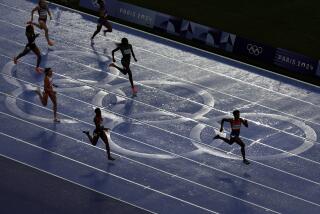COMMENTARY : Can Only Women Bare Their All in Sports Illustrated?
This year, in the Sports Illustrated swimsuit issue, the editors of the magazine reveal more than models.
They reveal a hypocrisy that outraged Canadians, prompted an athletic wear company to boycott their magazine and spawned charges of censorship, double-standards and misogyny.
This is the story of how Sports Illustrated--and its traditional defense of the annual swimsuit edition, released last week--lost all credibility.
Adidas Canada Ltd. was introducing a line of soccer wear and its advertising firm devised a catchy ad. It was scheduled to run last spring in Sports Illustrated’s Canadian edition. But right before press time, a Sports Illustrated editor in New York decided that the ad would offend the delicate sensibilities of his readers.
So he killed the ad. And he killed the ad because too much skin was showing. Male skin.
There was nothing graphic or prurient in this advertisement. It was just a photograph of 11 members of a semi-pro Canadian soccer club posing in a traditional team picture. Yes, the players were nude, but trophies, soccer balls and hands covered strategic areas. Above the photo was the slogan: “Your Team Will Not Be Taken Seriously If It’s Not Wearing Adidas.”
You can see as much of the male anatomy any day at the beach in Santa Monica as in the picture. And, of course, most of the swimsuit issue layouts are more revealing and more provocative. Even the ads in the swimsuit edition are more revealing than the Adidas photo. In this year’s issue is a full-page watch company ad featuring a close-up of a woman who wears either waxed dental floss or a skimpy white thong.
Adidas was outraged by Sports Illustrated’s double standard, said Steve Ralph, marketing services manager. The company, he said, is very conservative and showed the ad to employees, retailers and consumers before sending it to the magazine. No one, Ralph said, found it offensive. In fact, many of Adidas’ female employees liked the ad so much they posted it on their office walls.
The female managing editor of Sports Illustrated Canada, Ralph said, “not only approved the ad, but she loved it.” Then Adidas was told by an advertising executive that the managing editor of the U.S. edition, Mark Mulvoy, wanted the ad killed.
The problem, the executive told Ralph, was “the male nudity.”
Adidas executives argued that there is much more nudity in the swimsuit edition. But Sports Illustrated would not budge. Appalled by the magazine’s hypocrisy, Ralph said, Adidas declined to ever again advertise in it.
The magazine’s decision so outraged Canadian residents that the incident became a cause celebre. Polls showed that Canadians overwhelmingly opposed the cancellation. Adidas and its ad agency, Young and Rubicam, were deluged with calls of support. And columnists and editorial writers across the country vilified Sports Illustrated.
“Cross-border censorship!” one columnist wrote.
“Beefcake 0, Cheesecake 1,” wrote another.
A Toronto Star columnist wrote that the “annual swimsuit slobberfest” regularly features shots of: “Erect nipples straining through wet translucent tops, bare buttocks splayed over sand dunes and shorn pubic areas teasingly exposed by thongs that pass for water wear. . . . Female nudity is great for SI business, but male nudity is offensive to the tender predilections of the company’s decision makers.”
*
Sports Illustrated has managed to parlay jiggle journalism into big bucks. It aggressively markets the swimsuit models in cheesecake calenders and videos. It hypes the issue so extensively, and it has become so popular, that newsstand sales are usually up 100%, with ad rates jacked up.
When contacted last week about the double-standard charges, Sports Illustrated issued a tepid response.
“We don’t consider it good business to discuss advertiser-magazine relations,” said spokesman Roger Jackson.
And Managing Editor Mulvoy, the man who made the decision, the man who heads a magazine that attempts to persuade athletes to reveal their innermost thoughts, would not reveal his innermost thoughts about why he killed the ad. He declined to comment on the controversy.
A few years ago, Sports Illustrated, not content with merely hawking the upcoming swimsuit edition, ran a 3,500 word article touting it.
“The SI swimsuit issue . . . has become part and parcel of our culture, like Groundhog Day or spring training. . . . A tradition!” the writer gushed. And, in a winking aside, the writer referred to the magazine’s “mid-winter wickedness.”
*
Every year when the issue hits the streets, a debate commences. Some women’s groups argue that the layouts are exploitative and offensive. Sports Illustrated spokesmen contend that swimwear is merely athletic fashion and therefore appropriate in a sporting publication.
In the past, the dispute may have been a standoff. But in rejecting the recent Adidas ad, the magazine has blown its credibility.
The latest swimsuit edition, probably in an attempt to assuage critics after the Adidas fiasco, features a few shots of models with male water polo players in the background. But the men are never seen out of the pool. Tammy Bruce, president of the Los Angeles chapter of the National Organization for Women, says the magazine is “obsessed with keeping male bodies out of the magazine.”
“Yet they attempt to exploit women’s bodies at every opportunity,” she said. “This shows that the swimsuit edition has nothing to do with swimsuits--it’s just about exploiting women.”
While Canadians were thoroughly disillusioned with American journalistic ethics after the ad was banned, Adidas was able to turn a frustrating experience into a beau geste.
The company created a poster out of the banned ad. All 8,000 copies were quickly snapped up, and the profits were donated to the Special Olympics.






